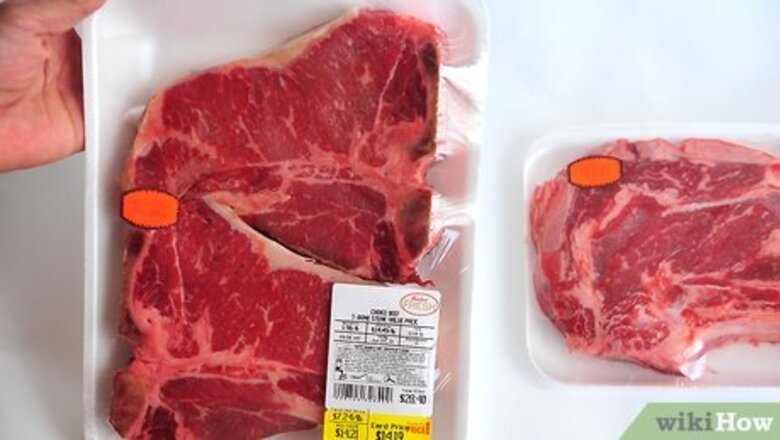
views
Preparing the Steak
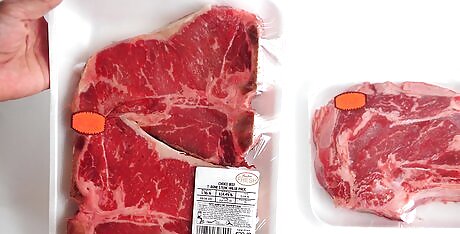
Choose your cut of meat. When people say "steak," what do they mean? While it's impossible to say that "steak" means any one cut, it does tend to mean certain cuts over others. Choose one that suits your liking, taking taste, juiciness, and price into consideration: T-bone: T-bone steaks are strip steaks and filet mignon separated by a bone shaped like a "T." It is a fan-favorite, but the fact that it comes from the cow's loin — where meat is extremely tender — makes it a little pricey. Porterhouse: Part tenderloin and part strip steak, the porterhouse is surprisingly like the T-bone steak, with a thin wedge of a bone between the two cuts to impart loads of flavor. Almost identical in price to the T-bone. Rib Eye: Ribeye comes from the rib of the steer, hence its name. It is what many of us think when the word "steak" comes to mind: It has beautiful marbling (thin layers of fat in between meat), giving it a silky texture and a robust taste. New York strip: New York strip steak comes from the short loin, a place where muscle is seldom used and therefore particularly tender. Although not as tender as a ribeye, New York strip steak has great marbling as well. Sirloin: "Sirloin" can refer to either top sirloin — a tasty but expensive cut of meat — or the bottom sirloin, in which case it's just called a sirloin steak. This cut comes from the rear back of the animal, near where the T-bone and porterhouse are.
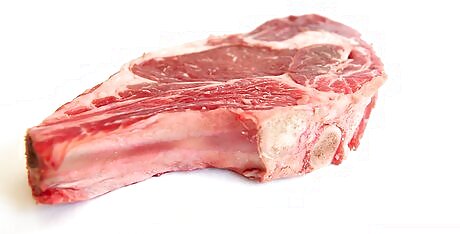
Buy a thick steak — anywhere from 1 ⁄2 inches (3.8 cm) to 2 inches (5.1 cm). Why are thick steaks better than thin steaks? With thin steaks, it's nearly impossible to get a perfectly brown, crispy outside and a pink, juicy interior. With thick steaks, getting that balance is a lot easier. It's always possible to share a 12 or 16 ounce steak with two or more people, and sharing one big steak between two people is always better than having one small steak per person.
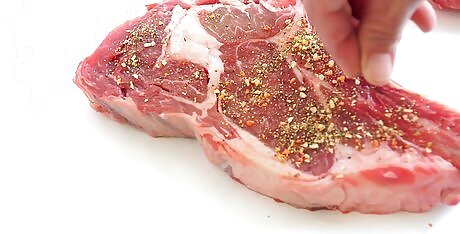
Add marinade or rub (optional). To soak or not to soak — that is the question. Many steak aficionados frown on the idea of adding anything but salt and pepper to a great cut of meat. And for good reason: The meat itself is supposed to shine. But if you do decide that you want to marinade your steak, now's the time to do it. Here are two simple ideas to add extra flavor to your steak if you so choose. Marinade: 1/3 cup soy sauce, 1/2 cup olive oil, 1/3 cup lemon juice, 1/4 cup Worcestershire, 2 pieces crushed garlic garlic, 1/2 cup chopped basil, 1/4 cup parsley. Marinade for 4 to 24 hours before cooking. Rub: 4 1/2 teaspoons kosher salt, 2 tablespoons fresh ground pepper, 2 tablespoons sweet paprika, 1 tablespoon onion powder, 1 tablespoon garlic powder, 1 tablespoon dried oregano leaves, 2 teaspoons ground cumin.

Let your steak reach room temperature. If your steak has been stored in the refrigerator while you waited for the perfect opportunity to grill it, now's the time to take it out. Getting your steak to room temperature will do two things: Hasten the cooking process. Meat that's warmer takes less time to cook. Harmonize the doneness of the outside and inside of the steak. If the steak has been refrigerated for a day, it will take longer for the internal temperature of the steak to come up. This means that you risk charring or burning the outside of the steak in order to cook the steak to medium on the inside.

If marinade or rub was not used, add salt now. The bigger the cut of meat, the more generous you should be about adding salt. Remember, there's twice as much meat in a 16 ounce T-bone as there is in an 8 ounce ribeye. Salt accordingly. Salt in advance. While some people salt up to four days in advance, only 40 minutes or so is strictly necessary. You can salt your steak and wait the requisite 40 minutes while it gets to room temperature. Why no pepper? Pepper can burn during the cooking process, while salt cannot. Burnt pepper doesn't taste very good, so it's better to apply it after the cooking has taken place.
Grilling Your Steak
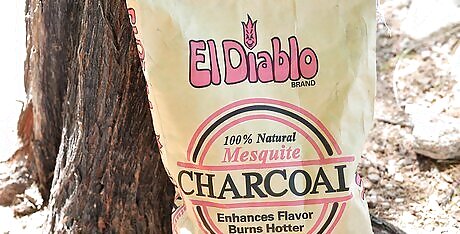
For best results, use hardwood coal. Briquettes can be used if you don't have hardwood coal (such as mesquite). But hardwood coal burns hotter and faster, making for a better final product. Of course, if you only have a gas grill, that's acceptable, too. Just be prepared for a different flavor from your steak in the end. Do not use lighter fluid to start your coals! Lighter fluid will give off fumes and can be tasted in the steaks. It's better to invest in a proper bbq chimney for preparing bbq steak.
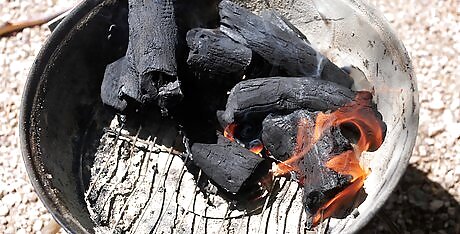
Arrange the all the hot coals on one half of the grill. This is your hot side of the grill. The other side is the cool side of the grill (even though it's still pretty darn hot). You're going to use the cool side of the grill to start with and the hot side of the grill later. It will help ensure a more perfect specimen of meat in the end.
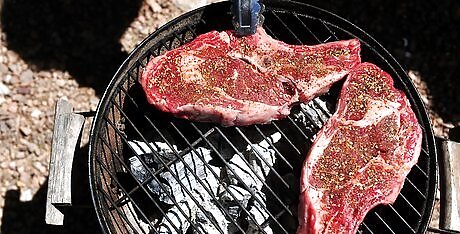
Start the steak on the cool side of the grill, where no coals are resting. Cover the lid and slowly allow the steak to start cooking using indirect heat. This, in fact, goes against common practice: Many people try searing the steak to begin with in order to "seal in the flavors." This practice has no basis in fact. If you start with your steak on the cool side of the grill, you're giving it enough time for the whole steak — not just the outside — to rise in temperature. Additionally, by the time your steak is nearly finished cooking, it's been given enough to develop a nice crust. All you have to do to finish is quickly move it over the hot portion of the coals.

Flip often to begin developing a crust on each side. Staying on the cool side of the grill, use tongs to flip your steak over often, about every minute or so. The grilling myth is that steaks should only be flipped once before serving. In fact, steaks which are flipped often over indirect heat cook more evenly and are juicier. When you're not flipping the steak, remember to put the cover on the grill.
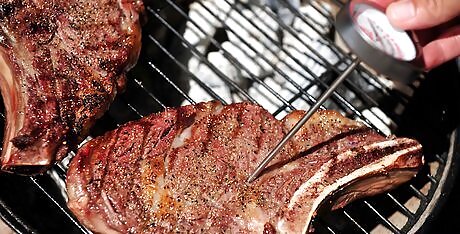
Use a thermometer to test for doneness. It may not sound very manly, but it sure is scientific. Plus, it works: Human judgment is a lot more fallible than a thermometer. We should all take note. Here's is the breakdown of how internal temperature breaks down to doneness: 120° F (48.8° C) = Rare 130° F (54.4° C) = Medium rare 140° F (60° C) = Medium 150° F (65.5° C) = Medium well 160° F (71.1° C) = Well done
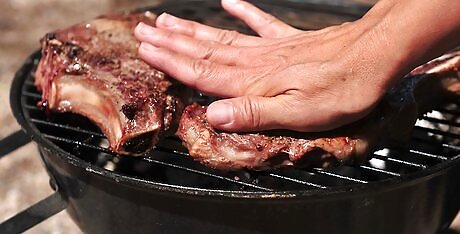
Alternately, use the finger test to help approximate doneness. The finger test involves touching the fleshy part of your palm underneath your thumb to approximate the doneness of a piece of meat. Open your hand and relax the palm. After each step, touch the inside of your palm with your other hand. Fingers not touching at all (palm open): This is what raw meat feels like. Thumb touching index finger: This is what rare meat feels like. Thumb touching middle finger: This is what medium-rare meat feels like. Thumb touching ring finger: This is what medium-well meat feels like. Thumb touching pinky: This is what well done meat feels like.

Once the meat is about 15° F below your ideal temperature, sear it quickly on both sides to develop color. If color has already developed, keep the meat on the cool side of the grill instead, as searing releases juices in the steaks.

Take your steak off the grill about 5° F before it reaches your ideal temperature. Why take it off before it's hit your ideal temperature? The steak will continue to rise internally by about 5° F after it's taken off the grill.
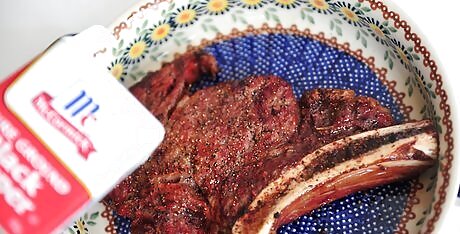
Season with pepper and let the steak rest for at least five minutes. As you cook your meat, the juices travel to the inside of your meat as the muscle fibers contract. If you cut your steak right after you take it from the grill, the juices in the center fall out more freely. If you wait for at least five minutes, the muscle fibers relax and the juices spread out more evenly throughout the whole steak.
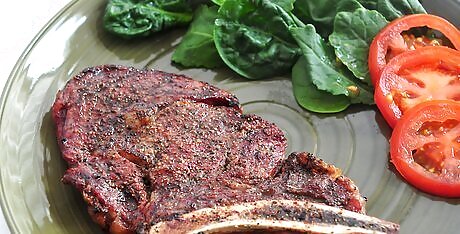
Enjoy. Enjoy your wonderfully cooked steak alongside some scalloped potatoes and garlic-sautéed spinach, for example.
Broiling Your Steak
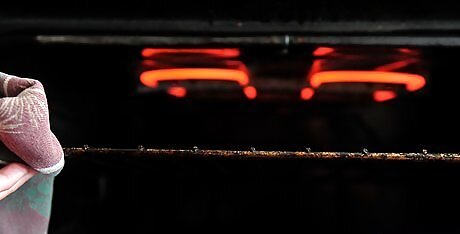
Position the rack you'll be using 4 to 6 inches (10.2 to 15.2 cm) below the top of the oven. This distance is probably the ideal distance if you want to cook your steak medium-rare or medium. If you want your steak to be a little rarer, position the rack down at 6 inches (15.2 cm). If you want your steak to be more well-done, position the rack at 4 inches (10.2 cm).
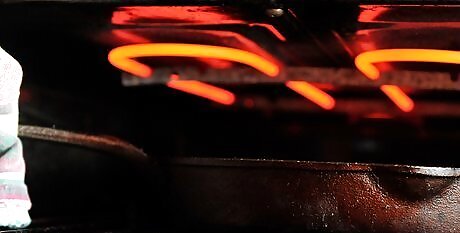
Turn on the broiler and set a large cast-iron pan inside the oven while it's preheating. Cast-iron pans are perfect for broiling because they conduct heat extremely well. If you don't have a cast-iron pan, a roasting pan or grill pan will also work. Preheat for 15 to 20 minutes to get the pan nice and hot.

Once the pan is finished preheating, place the steak onto the pan and broil for 3 minutes. If you're using a grill or a grill pan with raised ridges, lay the steak down at a diagonal so that you get good grill marks. Both the bottom and top of the steak should begin to sizzle if the oven is hot enough.
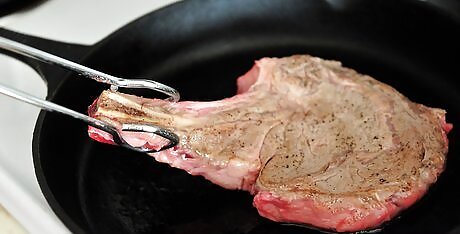
Flip the steak, and cook for another 3 minutes. Flip the steak using tongs, not a fork, as this will cause unnecessary and premature drainage of juices.
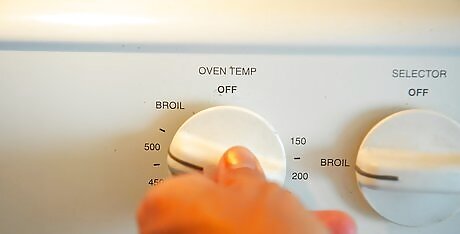
After 3 minutes on both sides, turn the oven down to 500° F (260° C).

Cook the steak according to the following chart. The chart below lists the approximate times to cook the steak at 500° F, given the thickness of the steak: Rare (120° to 130° F) 1" — 0-1 minute 1 1/4" — 2-3 minutes 1 3/4" — 4-5 minutes Medium (140° to 150° F) 1" — 2-3 minutes 1 1/4" — 4-5 minutes 1 3/4" — 6-7 minutes Medium Well (150° to 160° F) 1" — 4-5 minutes 1 1/4" — 6-7 minutes 1 3/4" — 8-9 minutes
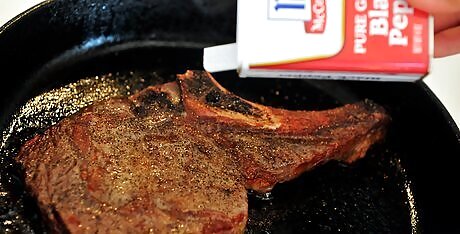
Season with pepper and let the steak rest for at least five minutes. As you cook your meat, the juices travel to the inside of your meat as the muscle fibers contract. If you cut your steak right after you take it from the grill, the juices in the center fall out more freely. If you wait for at least five minutes, the muscle fibers relax and the juices spread out more evenly throughout the whole steak.

Enjoy. Enjoy your wonderfully cooked steak alongside some green beans and a baked potato, for example.
Pan-Searing Your Steak
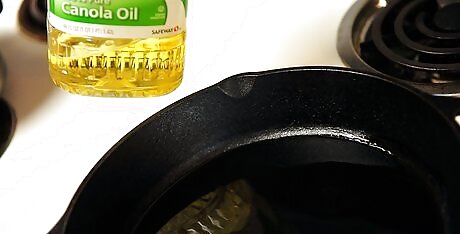
Heat 2 tablespoons of oil in a cast-iron skillet over high heat until heavily smoking. A cast-iron skillet is great at conducting heat, meaning that it spreads it out evenly over the entire surface. Use a nice neutral oil to cook the steak in. Olive oil is great for pasta and eggplant, but not so great for cooking steaks. Canola or another vegetable oil is probably better. If you prefer, you can use a teaspoon of butter instead of oil.
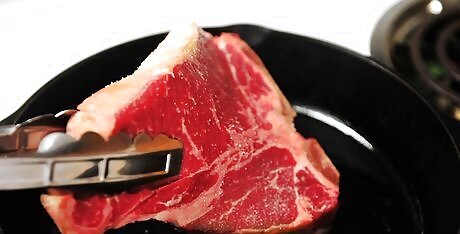
Add the steak to the pan, paying attention to placement if pan has raised ridges.
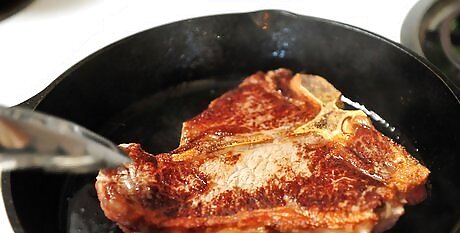
Flip frequently, about every minute or so, for about 6 to 12 minutes, until desired internal temperature has been reached. For best results, use a thermometer to check the internal temperature of the steak. Here's a guide of how internal temperature corresponds to doneness: 120° F (48.8° C) = Rare 130° F (54.4° C) = Medium rare 140° F (60° C) = Medium 150° F (65.5° C) = Medium well 160° F (71.1° C) = Well done
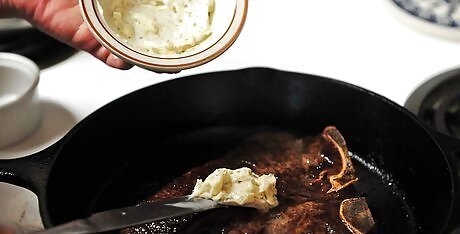
Before doneness has been reached, add 2 tablespoons (29.6 ml) of butter and any additional aromatics. Aromatics you may use while pan-searing may include: Rosemary Thyme Marjoram Garlic Sage
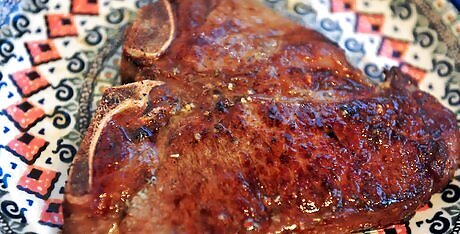
After steak is cooked (steak will continue to cook off the heat), allow it to rest for at least five minutes. As you cook your meat, the juices travel to the inside of your meat as the muscle fibers contract. If you cut your steak right after you take it from the grill, the juices in the center fall out more freely. If you wait for at least five minutes, the muscle fibers relax and the juices spread out more evenly throughout the whole steak.
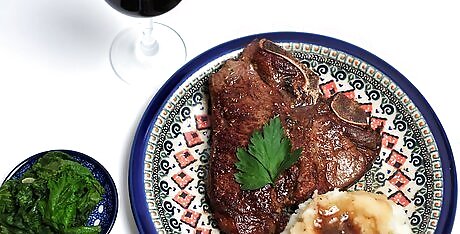
Enjoy. Enjoy your wonderfully cooked steak alongside some German potato salad and brussel sprouts, for example.



















Comments
0 comment